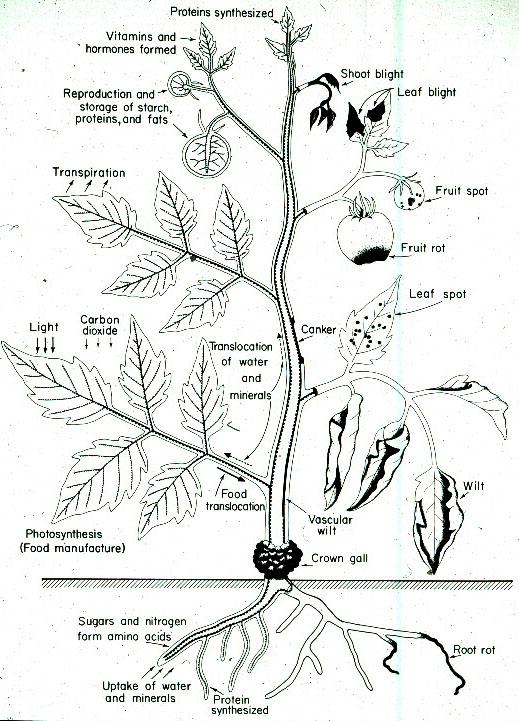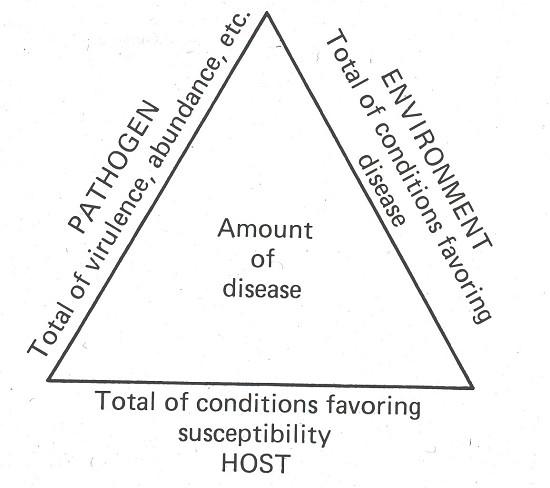Contact Us
University of California Cooperative Extension Ventura County
669 County Square Drive, Suite 100
Ventura, CA 93003
Phone: 805.645.1451
Fax: 805.645.1474
Office Hours:
Monday - Friday from 9 a.m. to 4 p.m.
The office will be closed for the following holidays:
Ten Principles of Plant Pathology
This definition of plant disease includes organismal causal agents which attack plants such as fungi, bacteria, mycoplasma, viruses, nematodes and parasitic plants. However, for ornamental plants abiotic diseases far outweigh the traditional causes of plant diseases. For ornamental plants the Plant Pathologist must first examine such abiotic diseases as: 1) high or low temperatures, 2) excess or deficiency of water, 3) excess or deficiency of light, 4) lack of oxygen, 5) air pollution, 6) nutrient deficiencies, 7) mineral toxicities, 8) soil alkalinity or acidity, 9) toxicity of pesticides, 10) improper cultural practices and 11) lightening, before suspecting that the disease is caused by an organism. In many cases “diseases” which apply to ornamental or backyard plants may not be diseases at all since they do not cause a malfunction of the plant but instead cause an unpleasant response on behalf of the home owner. Examples of these “diseases” may be slime mold fungi, which cover plants or fairy rings, which cause the lawn to be unsightly. So “plant disease” often depends on your perspective.

Fig1. Diseases and the plant organs they effect.
How the disease affects a plant and what organs it causes to malfunction can aid in the diagnoses and control of plant diseases (Fig.1). Leaf diseases are commonly associated with necrotic spots and/or signs of the disease such as spores or fruiting bodies of the attacking fungus. A common mistake made by homeowners is to assume that dying leaves are caused by leaf diseases. More often than not if the plant suddenly wilts or shows symptoms on all leaves the disease is caused by either a blockage in the water conducting vessels, which is called a “wilt disease” or it is caused by a “root rot disease”. These two types of disease are often difficult to separate simply by viewing the gross symptoms of the plant. The plant stem must be severed to look for telltale stains in the stem caused by wilt diseases and the roots must be examined for symptoms of root decay. Cankers are a fourth type of disease which are usually characterized by conspicuous lesions on the stem or branches. This type of disease does not interfere with the water movement in a plant but with the movement of sugars and other substances in the phloem. With this rudimentary knowledge of the disease it is possible to narrow your diagnosis to the plant organs which are affected. A search of these organs for further symptoms or signs of disease will usually result in a proper disease diagnosis. However, isolation or identification of biotic pathogens is required for a final diagnosis.
The concept that plant disease is not caused by a single organism or disease agent is overlooked by most people. Plant disease is instead caused by a combination of three factors: 1) a pathogen, 2) environmental conditions, and 3) host response. This concept is visualized by the “disease triangle” in which the three factors, pathogen, environment and host make up the three sides of a triangle and the are of the triangle is the amount of disease produced in the plant(Fig.2). The disease triangle shows visually that a very weak and inefficient pathogen could cause substantial disease if the environment is conducive or if the host is extremely susceptible.

Fig 2. Disease triangle
Principle III - Conditions which favor plant growth and health commonly favor disease.
One of the most common misconceptions among horticulturists and the public is that healthy plants are somehow more resistant to plant disease and so abundant water and fertilizer are often treated as pesticides to insure plant health. While this may be true for weak or opportunistic plant pathogens it is not true for most competent pathogens. For example, high levels of nitrogen fertilizers, which result in rapid growth of plants, is often prescribed to improve plant health. Not only does this commonly result in ammonia toxicity, but high levels of nitrogen are known to exacerbate disease by many pathogens such as Rhizoctonia, Pythium, Phytophthora, Fusarium, Armillaria, Sclerotium, Pseudomonas, Corynebacterium, powdery mildews, rusts, cyst nematodes and many others.
Perhaps the most common plant problems, for most home owners and for ornamental plants in general, results from improper watering. Plants damaged by growing in water saturated soil can often be diagnosed by the foul hydrogen cyanide odor of the soil. Plants which are chronically drought stressed usually have leaves which have brown necrotic tips or edges. However, most people are not aware that overwatering or underwatering can predispose plants to disease. Predisposition is the environmental modification of plant resistance making the plant more susceptible to disease. Exposing roots to saturated water conditions for as little as 18 hours damages the sensitive root membranes and results in leakage of nutrients from the root cells. This is called root exudation and many pathogens are attracted to root exudates and will preferentially attack roots which are leaking exudates. Overwatered plants often become more susceptible to root rot fungi such as Phytophthora and Pythium. Underwatering plants appears to make them less able to fight off invading pathogens and drought stressed plants are more susceptible to cankers caused by Botryosphaeria (Fusicoccum) and Hendersonula.
Plant diseases are often extremely difficult to control and require a flexible approach which utilizes all of the tools available to us. In most situations, utilizing several methods to control disease is more practical and efficient than relying on a single method. An example of cultural control is mulching which will often reduce root rot caused by Phytophthora. Epidemiology is the study of factors affecting the outbreak and spread of infectious disease. Familiarity with the epidemiology of a pathogen will show how factors such as temperature, rainfall, wind and leaf wetness affect its ability to produce spores, spread and infect its host. Knowledge of epidemiology will often lead to the formulation of “models” which forecast or predict disease. Simple models such as rainfall for longer than 24 hours when the temperature is above 24C requires a fungicide spray are often the best and most useful means of both controlling a disease and reducing the amount of fungicide applied. Resistant varieties are often the ultimate way to control disease. However, the resistance may break down and for many ornamental plants resistance is simply not available. Chemical pesticides are often the only effective way to control disease. New IPM (Integrated Pest Management) guidelines stress using only enough pesticide to control the disease and to constantly look for ways to reduce pesticide applications. Biological control of plant pathogens is not as advanced as it is in insect control. While there are substantial numbers of biological control agents on the market, most are not very efficacious for control of diseases in the field.
While this principle seems self evident, it is amazing how many homeowners are more interested in saving their tree than in the potential danger to their house, car or their own person. Wood decay organisms often damage only the dead, central heartwood portion of the tree causing the tree to be hollow. The tree shows very little outward signs of the damage since one or two outer rings of the trunk can conduct all the water and nutrients to sustain the tree. Fruiting bodies of the wood decay fungi, which resemble brackets or shelves, are signs that the tree may in danger of breaking and falling over. Two of our most common wood decay fungi in Southern California are Ganoderma and Laetiporus.
New pests and diseases are constantly being introduced into Southern California simply because there are more people traveling today than ever before. Notices in airports and borders plead with visitors not to bring in plant material which may harbor new diseases. However despite our best efforts new diseases are introduced and because our plants have little resistance to introduced species and there are no competitors or predators to keep their numbers low, and a epidemic occurs which is very difficult to control. The cost to the US for introduced species is in excess of $137 billion. This seems low to me because of the costs due to the loss of chestnut trees due to the introduction of chestnut blight, the loss of white pine due to the introduction of white pine blister rust, the loss of elm trees due to the introduction of Dutch elm disease and avocado losses due to the introduction of avocado root rot. Invasive diseases of these four trees alone have resulted in billions in losses at today’s prices. Despite the massive losses due to introduced species our state and federal government continues to reduce quarantine efforts at our borders.
This principle is really a corollary of Principle VIII, and is I am afraid being ignored today in this atmosphere of free trade.
This is really the first rule of plant pathology. Certainly our state and federal governments are ignoring this rule when they downgrade our quarantine system. However, this rule is really aimed at the farmer or homeowner who tries to control disease without really understanding plant pathology. Diseases are commonly exacerbated by overwatering and overfertilization by well meaning gardeners. Plant pathologists term efforts to control disease which result in worse disease as boomerang effects. A classic example of the boomerang effect occurs if a soil-borne pathogen reinvades fumigated soil. Without natural enemies to reduce its spread it often becomes far worse than it would have been before fumigation. Disease trading is another term which results when one disease is controlled but another is exacerbated by the same treatment.
Agrios, G. N. 1988. Plant Pathology. Academic Press Inc., San Diego, 803p.
Horsefall, J. G. and E. B. Cowling. 1980. Plant Disease. An Advanced treatise. Vol. 1-5. Academic Press Inc., San Diego.
Yarwood, C. E. 1962. Some principles of plant pathology. Phytopathology 52:166-167.
Yarwood, C. E. 1973. Some principles of plant pathology II. Phytopathology 63:1324-1325.
